Icosagon
| Regular icosagon | |
|---|---|
|
A regular icosagon | |
| Type | Regular polygon |
| Edges and vertices | 20 |
| Schläfli symbol |
{20} t{10} |
| Coxeter diagram |
|
| Symmetry group | Dihedral (D20), order 2×20 |
| Internal angle (degrees) | 162° |
| Dual polygon | self |
| Properties | convex, cyclic, equilateral, isogonal, isotoxal |
In geometry, an icosagon is a twenty-sided polygon. The sum of any icosagon's interior angles is 3240 degrees.
The regular icosagon is a constructible polygon, by an edge-bisection of a regular decagon, and can be seen as a truncated decagon, t{10}. One interior angle in a regular icosagon is 162°, meaning that one exterior angle would be 18°.
Regular Icosagon
The area of a regular icosagon is: (with t = edge length)
Uses
The Big Wheel on the popular US game show The Price Is Right is an icosagon.
The Globe, the outdoor theater used by William Shakespeare's acting company, was discovered to have been built on an icosagonal foundation when a partial excavation was done in 1989.[1]
As a golygonal path, the swastika is considered to be an irregular icosagon.[2]
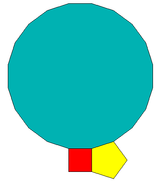 A regular square, pentagon, and icosagon can completely fill a plane vertex.
A regular square, pentagon, and icosagon can completely fill a plane vertex.
Construction
A regular icosagon is constructible using a compass and straightedge:

Construction of a regular icosagon
Related polygons
An icosagram is a 20-sided star polygon, represented by symbol {20/n}. There are 3 regular forms given by Schläfli symbols: {20/3}, {20/7}, and {20/9}. There are also 5 regular star figures (compounds) using the same vertex arrangement: 2{10}, 4{5}, 5{4}, 2{10/3}, 4{5/2}, and 10{2}.
| n | 1 | 2 | 3 | 4 | 5 |
|---|---|---|---|---|---|
| Form | Convex polygon | Compound | Star polygon | Compound | |
| Image |  {20/1} = {20} |
.svg.png) {20/2} = 2{10} |
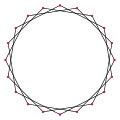 {20/3} |
.svg.png) {20/4} = 4{5} |
.svg.png) {20/5} = 5{4} |
| Interior angle | 162° | 144° | 126° | 108° | 90° |
| n | 6 | 7 | 8 | 9 | 10 |
| Form | Compound | Star polygon | Compound | Star polygon | Compound |
| Image | .svg.png) {20/6} = 2{10/3} |
 {20/7} |
.svg.png) {20/8} = 4{5/2} |
 {20/9} |
.svg.png) {20/10} = 10{2} |
| Interior angle | 72° | 54° | 36° | 18° | 0° |
Deeper truncations of the regular decagon and decagram can produce isogonal (vertex-transitive) intermediate icosagram forms with equally spaced vertices and two edge lengths.[3]
A regular icosagram, {20/9}, can be seen as a quasitruncated decagon, t{10/9}={20/9}. Similarly a decagram, {10/3} has a quasitruncation t{10/7}={20/7}, and finally a simple truncation of a decagram gives t{10/3}={20/3}.
| Quasiregular | Quasiregular | ||||
|---|---|---|---|---|---|
 t{10}={20} |
 |
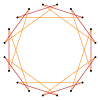 |
 |
 |
 t{10/9}={20/9} |
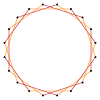 t{10/3}={20/3} |
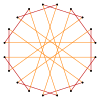 |
 |
 |
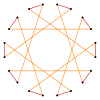 |
 t{10/7}={20/7} |
Petrie polygons
The regular icosagon is the Petrie polygon for a number of higher-dimensional polytopes, shown in orthogonal projections in Coxeter planes:
| A19 | B10 | D11 | E8 | H4 | 2H2 | ||
|---|---|---|---|---|---|---|---|
 19-simplex |
 10-orthoplex |
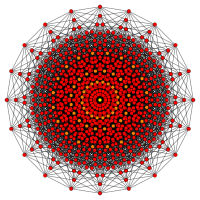 10-cube |
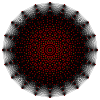 11-demicube |
 (421) |
 600-cell |
 10-10 duopyramid |
 10-10 duoprism |
It is also the Petrie polygon for the icosahedral 120-cell, small stellated 120-cell, great icosahedral 120-cell, and great grand 120-cell.
References
- ↑
- ↑ Weisstein, Eric W., "Icosagon", MathWorld.
- ↑ The Lighter Side of Mathematics: Proceedings of the Eugène Strens Memorial Conference on Recreational Mathematics and its History, (1994), Metamorphoses of polygons, Branko Grünbaum
| ||||||||||||||||||||||||||

